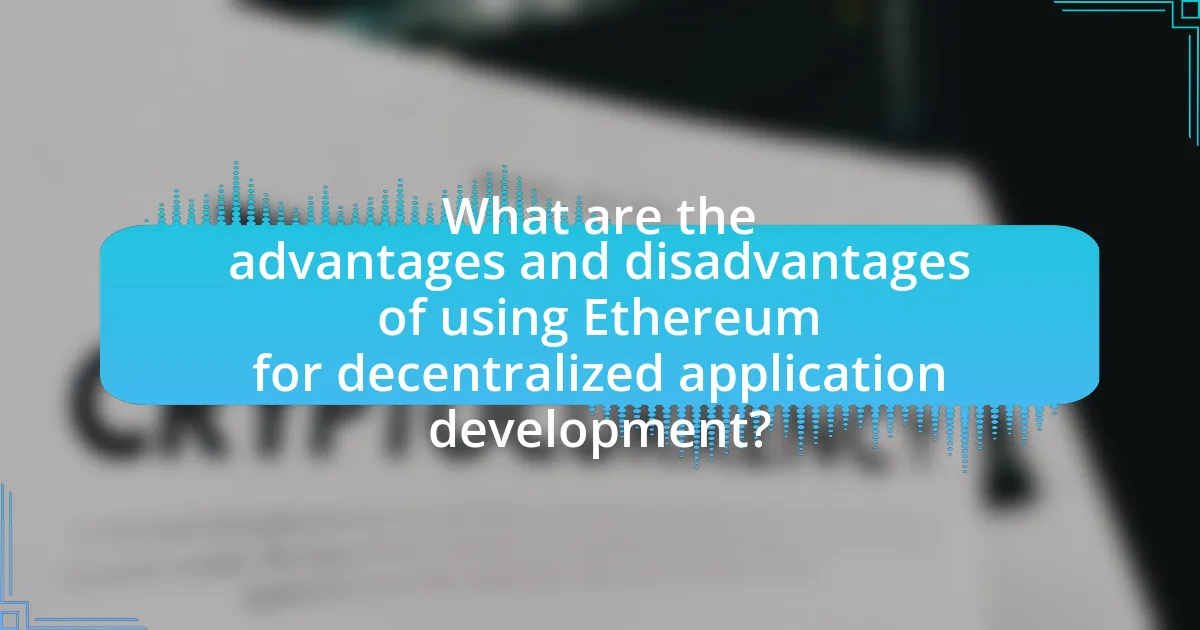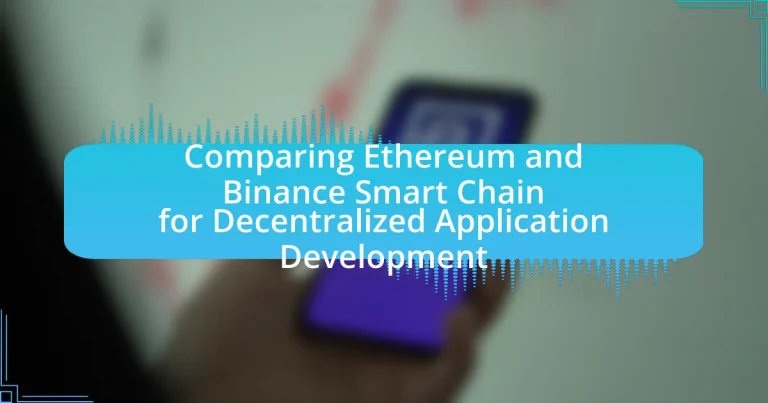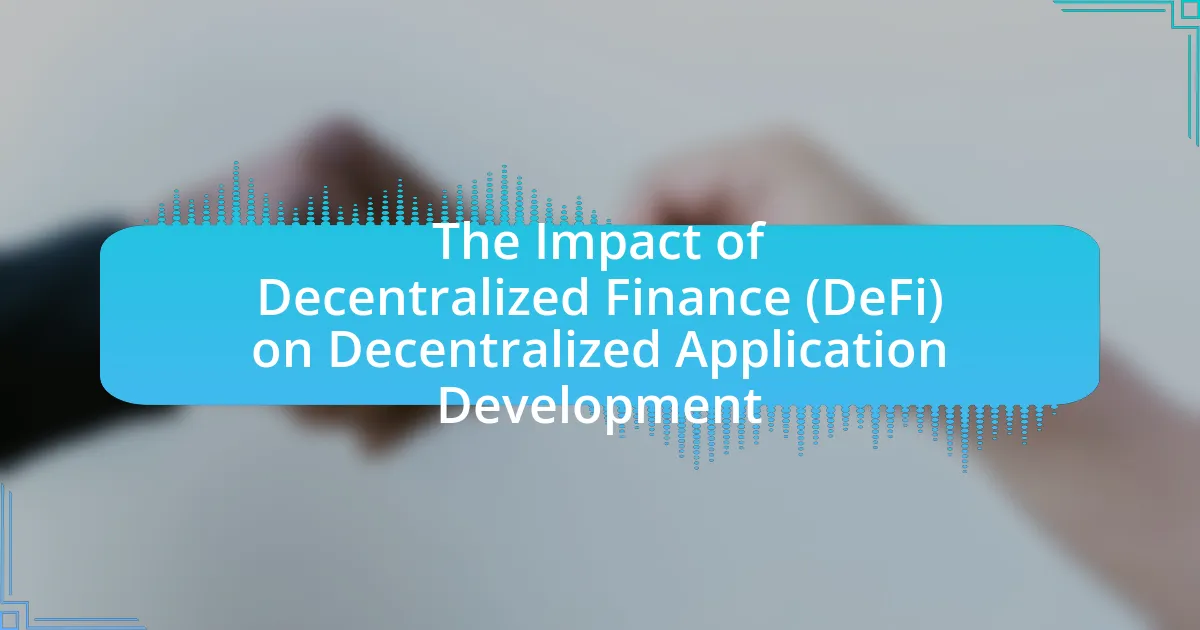The article compares Ethereum and Binance Smart Chain (BSC) as platforms for decentralized application (dApp) development, highlighting their key differences in consensus mechanisms, transaction speeds, and costs. Ethereum, transitioning to a proof-of-stake model, offers a robust ecosystem and extensive developer resources but faces challenges with higher fees and slower transaction times. In contrast, BSC employs a proof-of-staked authority mechanism, providing faster transactions and lower fees, making it an attractive option for developers focused on cost-effectiveness and efficiency. The article further explores the advantages and disadvantages of each platform, their respective developer communities, and specific use cases that showcase their strengths in the dApp landscape.

What are the key differences between Ethereum and Binance Smart Chain for decentralized application development?
Ethereum and Binance Smart Chain (BSC) differ primarily in their consensus mechanisms, transaction speeds, and fees, impacting decentralized application (dApp) development. Ethereum utilizes a proof-of-work (PoW) mechanism, transitioning to proof-of-stake (PoS), which can lead to slower transaction times and higher fees, averaging around $5 to $15 per transaction during peak usage. In contrast, BSC employs a proof-of-staked authority (PoSA) consensus, allowing for faster transactions, typically under 3 seconds, and significantly lower fees, often less than $0.10. Additionally, Ethereum has a larger developer community and more established dApp ecosystem, while BSC offers compatibility with Ethereum’s tooling, enabling easier migration of dApps. These differences influence developers’ choices based on scalability, cost, and community support.
How do Ethereum and Binance Smart Chain differ in terms of consensus mechanisms?
Ethereum utilizes a Proof of Stake (PoS) consensus mechanism, while Binance Smart Chain (BSC) employs a Proof of Staked Authority (PoSA) model. Ethereum’s PoS allows validators to create new blocks and confirm transactions based on the amount of cryptocurrency they hold and are willing to “stake” as collateral, enhancing security and energy efficiency. In contrast, BSC’s PoSA combines elements of both PoS and delegated Proof of Authority (PoA), where a limited number of validators are selected based on their stake, allowing for faster block times and lower transaction fees. This fundamental difference in consensus mechanisms impacts scalability, security, and decentralization between the two platforms.
What is the consensus mechanism used by Ethereum?
Ethereum uses a consensus mechanism called Proof of Stake (PoS). This mechanism was implemented with the Ethereum 2.0 upgrade, transitioning from the previous Proof of Work (PoW) system. Proof of Stake allows validators to create new blocks and confirm transactions based on the number of coins they hold and are willing to “stake” as collateral, enhancing energy efficiency and scalability. The shift to PoS aims to improve network security and reduce the environmental impact associated with mining, as evidenced by Ethereum’s significant reduction in energy consumption post-upgrade.
What is the consensus mechanism used by Binance Smart Chain?
The consensus mechanism used by Binance Smart Chain is Proof of Staked Authority (PoSA). This mechanism combines elements of both Proof of Authority and Delegated Proof of Stake, allowing for faster block times and lower transaction fees. PoSA enables a limited number of validators to produce blocks, which enhances efficiency and scalability, making it suitable for decentralized applications.
What are the transaction speed and costs on Ethereum compared to Binance Smart Chain?
Ethereum typically has a transaction speed of 15 to 30 transactions per second (TPS) and costs can range from $1 to over $100 during peak times, depending on network congestion. In contrast, Binance Smart Chain (BSC) offers a transaction speed of approximately 60 to 100 TPS with significantly lower costs, averaging around $0.10 to $1 per transaction. This stark difference in both speed and cost makes BSC a more efficient option for decentralized application development, especially during high-demand periods on Ethereum.
How does Ethereum’s transaction speed impact decentralized application development?
Ethereum’s transaction speed significantly impacts decentralized application (dApp) development by influencing user experience and scalability. A slower transaction speed can lead to delays in processing user interactions, which may frustrate users and deter them from using the application. For instance, Ethereum’s average transaction time can range from 15 seconds to several minutes, depending on network congestion, which can hinder real-time applications like gaming or finance.
Moreover, the scalability issues associated with Ethereum’s transaction speed can limit the number of concurrent users and transactions, affecting the overall performance of dApps. In contrast, platforms like Binance Smart Chain offer faster transaction speeds, often under 3 seconds, allowing developers to create more responsive and scalable applications. This difference in transaction speed is crucial for developers when choosing a blockchain platform, as it directly affects the usability and adoption of their dApps.
What are the transaction costs associated with using Binance Smart Chain?
The transaction costs associated with using Binance Smart Chain (BSC) are significantly lower than those on Ethereum, typically ranging from $0.10 to $0.50 per transaction. This cost efficiency is primarily due to BSC’s consensus mechanism, which utilizes a Proof of Staked Authority (PoSA) model, allowing for faster block times and lower fees compared to Ethereum’s Proof of Work (PoW) model. As of October 2023, the average transaction fee on BSC is approximately 0.0005 BNB, which is substantially cheaper than Ethereum’s average fees that can exceed $20 during peak times. This cost structure makes BSC an attractive option for developers and users seeking to minimize expenses in decentralized application development.

What are the advantages and disadvantages of using Ethereum for decentralized application development?
Ethereum offers several advantages for decentralized application development, including a robust ecosystem, extensive developer resources, and strong security features. Its large community and established infrastructure facilitate the creation and deployment of smart contracts, which are essential for decentralized applications. Additionally, Ethereum’s transition to a proof-of-stake consensus mechanism enhances scalability and energy efficiency.
However, Ethereum also has disadvantages, primarily high transaction fees and slower processing times compared to some alternatives. During periods of high network congestion, gas fees can become prohibitively expensive, which may deter developers and users. Furthermore, the complexity of Ethereum’s programming language, Solidity, can pose a learning curve for new developers.
In summary, while Ethereum provides a strong foundation for decentralized application development through its extensive resources and security, challenges such as high costs and complexity may impact its attractiveness compared to other platforms.
What unique features does Ethereum offer to developers?
Ethereum offers developers unique features such as a robust smart contract functionality, a large developer community, and extensive tooling and libraries. The smart contract functionality allows for the creation of decentralized applications (dApps) that can automate processes and execute transactions without intermediaries. Ethereum’s large developer community fosters collaboration and innovation, providing access to a wealth of resources and support. Additionally, Ethereum’s ecosystem includes various development tools like Truffle and Hardhat, which streamline the development process and enhance productivity. These features collectively position Ethereum as a leading platform for decentralized application development.
How does Ethereum’s smart contract functionality enhance application development?
Ethereum’s smart contract functionality enhances application development by enabling developers to create self-executing contracts with predefined rules and conditions. This capability allows for automation of processes, reducing the need for intermediaries and increasing efficiency. For instance, Ethereum’s Solidity programming language provides a robust framework for building decentralized applications (dApps), allowing developers to leverage features like token standards (e.g., ERC-20, ERC-721) that facilitate the creation of fungible and non-fungible tokens. Additionally, Ethereum’s extensive developer community and established ecosystem provide access to a wealth of resources, tools, and libraries, further accelerating the development process. The network’s high level of security, achieved through its consensus mechanism, also ensures that applications built on Ethereum are resilient against attacks, thereby fostering trust among users.
What challenges do developers face when using Ethereum?
Developers face several challenges when using Ethereum, primarily including high transaction fees, scalability issues, and a steep learning curve. High transaction fees, often exceeding several dollars during peak times, can deter users and limit the feasibility of certain applications. Scalability issues arise from Ethereum’s current proof-of-work consensus mechanism, which can handle only about 15 transactions per second, leading to network congestion. Additionally, the complexity of smart contract development requires developers to have a solid understanding of Solidity, Ethereum’s programming language, which can be a barrier for newcomers. These challenges impact the overall efficiency and accessibility of decentralized application development on the Ethereum platform.
How does the developer community and ecosystem support differ between Ethereum and Binance Smart Chain?
The developer community and ecosystem support for Ethereum is significantly more extensive and established compared to Binance Smart Chain. Ethereum boasts a larger number of developers, with over 4,000 active contributors on GitHub, and a rich ecosystem of tools, libraries, and frameworks such as Truffle and Hardhat, which facilitate decentralized application development. In contrast, Binance Smart Chain, while growing rapidly, has a smaller community and fewer resources, with around 1,000 active contributors, and relies heavily on Ethereum’s existing tools due to its compatibility with the Ethereum Virtual Machine (EVM). This disparity in community size and resource availability impacts the level of support developers receive, with Ethereum offering more comprehensive documentation, forums, and community events, such as Devcon, which foster collaboration and innovation.
What resources are available for Ethereum developers?
Ethereum developers have access to a variety of resources including official documentation, development tools, and community support. The Ethereum Foundation provides comprehensive documentation at ethereum.org, which covers everything from smart contract development to network protocols. Tools such as Truffle, Hardhat, and Remix facilitate the development process by offering frameworks for building and testing decentralized applications. Additionally, platforms like GitHub host numerous open-source projects and libraries that developers can utilize. Community forums, such as Ethereum Stack Exchange and Discord channels, offer peer support and knowledge sharing, enhancing the collaborative environment for developers.
How does Binance Smart Chain’s community contribute to its ecosystem?
Binance Smart Chain’s community significantly contributes to its ecosystem by actively participating in governance, development, and user engagement. Community members influence decision-making processes through voting on proposals, which shapes the direction of the platform. Additionally, developers within the community create decentralized applications (dApps) and tools that enhance functionality and user experience, evidenced by the rapid growth of dApps on the platform, which surpassed 1,000 in 2021. Furthermore, user engagement through educational initiatives and social media outreach fosters a vibrant ecosystem, attracting new users and developers, thereby increasing overall network activity and liquidity.

What specific use cases highlight the strengths of Ethereum and Binance Smart Chain?
Ethereum excels in decentralized finance (DeFi) applications, evidenced by platforms like Uniswap and Aave, which leverage Ethereum’s robust smart contract capabilities and extensive developer community. In contrast, Binance Smart Chain (BSC) showcases its strengths in high-speed transactions and lower fees, highlighted by projects like PancakeSwap, which attracts users seeking efficient trading experiences. Ethereum’s dominance in NFT marketplaces, such as OpenSea, further underscores its versatility, while BSC’s rapid growth in gaming applications, like CryptoBlades, demonstrates its appeal for developers prioritizing cost-effectiveness and speed.
What types of decentralized applications are best suited for Ethereum?
Decentralized applications best suited for Ethereum include decentralized finance (DeFi) platforms, non-fungible token (NFT) marketplaces, and decentralized autonomous organizations (DAOs). Ethereum’s robust smart contract functionality and widespread adoption make it ideal for DeFi applications, which facilitate lending, borrowing, and trading without intermediaries. The NFT marketplaces thrive on Ethereum due to its established standards like ERC-721 and ERC-1155, enabling unique digital asset ownership. Additionally, DAOs leverage Ethereum’s capabilities to create governance structures that allow token holders to participate in decision-making processes. Ethereum’s extensive developer community and network effects further validate its suitability for these types of applications.
How do DeFi projects leverage Ethereum’s capabilities?
DeFi projects leverage Ethereum’s capabilities by utilizing its smart contract functionality to create decentralized financial applications that enable peer-to-peer transactions without intermediaries. Ethereum’s robust ecosystem supports a wide range of DeFi protocols, including lending, borrowing, and trading platforms, which benefit from its security, transparency, and programmability. The Ethereum blockchain processes over 1 million transactions daily, showcasing its scalability and reliability for DeFi applications. Additionally, the Ethereum Virtual Machine (EVM) allows developers to deploy complex financial instruments, enhancing innovation within the DeFi space.
What role does NFTs play in Ethereum’s application landscape?
NFTs serve as a pivotal component in Ethereum’s application landscape by enabling unique digital ownership and provenance through smart contracts. This functionality allows creators to tokenize art, music, and other digital assets, facilitating a new economy around digital collectibles and virtual goods. As of 2023, Ethereum hosts the majority of NFT transactions, accounting for over 90% of the market share, which underscores its dominance in this sector. The ERC-721 and ERC-1155 standards specifically designed for NFTs have established a framework that supports interoperability and diverse use cases, further solidifying Ethereum’s position as the leading platform for NFT development.
What types of decentralized applications thrive on Binance Smart Chain?
Decentralized applications that thrive on Binance Smart Chain include decentralized finance (DeFi) platforms, non-fungible token (NFT) marketplaces, and gaming applications. DeFi platforms, such as PancakeSwap and Venus, leverage Binance Smart Chain’s low transaction fees and fast block times to provide users with efficient trading and lending services. NFT marketplaces like BakerySwap and Treasureland utilize the chain’s capabilities to facilitate the creation and trading of digital assets. Additionally, gaming applications, including CryptoBlades and My DeFi Pet, benefit from the scalability and cost-effectiveness of Binance Smart Chain, attracting a growing user base. These types of applications demonstrate the versatility and appeal of Binance Smart Chain for developers and users alike.
How do gaming applications utilize Binance Smart Chain’s features?
Gaming applications utilize Binance Smart Chain’s features by leveraging its low transaction fees and high throughput to enhance user experience and scalability. The Binance Smart Chain supports smart contracts, allowing developers to create decentralized games that can handle numerous transactions simultaneously without incurring high costs. For instance, the average transaction fee on Binance Smart Chain is significantly lower than that on Ethereum, making it economically viable for microtransactions common in gaming. Additionally, the fast block times on Binance Smart Chain, averaging around 3 seconds, enable real-time interactions within games, which is crucial for maintaining player engagement. This combination of affordability and speed allows gaming applications to implement features like in-game asset trading and reward systems efficiently.
What advantages do Binance Smart Chain applications have in terms of user experience?
Binance Smart Chain applications offer several advantages in terms of user experience, primarily due to their lower transaction fees and faster confirmation times. Users benefit from significantly reduced costs, with average transaction fees on Binance Smart Chain being around $0.10 compared to Ethereum’s average fees, which can exceed $10 during peak times. Additionally, Binance Smart Chain achieves block confirmation times of approximately 3 seconds, allowing for quicker interactions and a more seamless experience for users engaging with decentralized applications. These factors contribute to a more efficient and user-friendly environment, making Binance Smart Chain an attractive option for developers and users alike.
What best practices should developers follow when choosing between Ethereum and Binance Smart Chain?
Developers should evaluate transaction fees, network speed, and community support when choosing between Ethereum and Binance Smart Chain. Ethereum typically has higher transaction fees due to its popularity and network congestion, while Binance Smart Chain offers lower fees, making it more cost-effective for developers. Additionally, Ethereum has a larger developer community and more established tools, which can facilitate development. Conversely, Binance Smart Chain provides faster transaction speeds, which can enhance user experience. These factors are critical for developers to consider based on their project requirements and target audience.

















